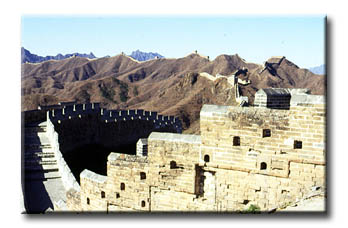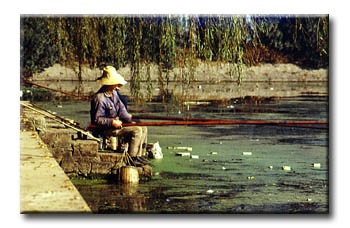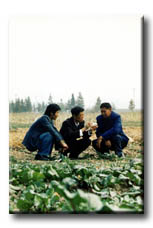Navigation
Spiders Reduce Risks, Increase Yields for China's Farmers
Worldwide, about a million people are poisoned by pesticides each year; ten thousand of these victims die from such poisonings. The risks are greatest in developing countries. Ninety-nine percent of the deaths caused by agricultural chemicals occur in those countries.
Spiders Help Farmers Grow Safer Crops One Second Before Sunrise II Part 2.mov
Spiders Help Farmers Grow Safer Crops takes you from Harbin in northern China to Wuhan on the Yangzi River and into the San Joaquin Valley in California. Dr. Zhao Jing Zhao's innovative use of spiders to control cotton pests in the People's Republic of China demonstrates the significant role of integrated pest management as a means to reduce the use of harmful chemicals while increasing agricultural productivity. Cotton growers in Hubei have increased their yields while reducing the use of pesticides by 70-90%. In California, host Lynn Redgrave talks about integrated pest management with a local expert in the cotton fields of San Joaquin Valley. Spiders are protecting cotton against predators in the fields of Wuhan, while delicate green lacewings are protecting cotton in the fields of California. Once Second Before Sunrise Part 2: Spiders Help Farmers Grow Safer Crops, is a Horizon International co-production with Hei Long Jiang Television, People's Republic of China. This episode, part of a one-hour TV program that included Cooperating for Clean Air: A Horizon International co-production with SVTV2, Swedish Television had its broadcast premier nationwide on PBS in the United States and in China in 1993. Janine Selendy is Executive Producer, Co-Producer and Director. Hosted and narrated by Lynn Redgrave. Roger P. Swain, Ph.D., Science Editor, Horticulture magazine and member of the Horizon International Scientific Review Board was the on and off-site advisor. Music is by Joe Mennona. Additional production credits are at the end of the program. Horizon's other TV programs can be seen here on YouTube and at www.horizoninternationaltv.org. Horizon International features articles, case studies and exhibits on the Horizon Solutions Site at www.solutions-site.org and on it oceans and coral reefs website www.magicporthole.org.
Location:
Hubei Province, China
Problem Overview:
Worldwide, about a million people are poisoned by pesticides each year; ten thousand of these victims die from such poisonings. The risks are greatest in developing countries. Ninety-nine percent of the deaths caused by agricultural chemicals occur in those countries.
Many farm workers cannot read the warning labels about careful use, because they do not know how to read or because the label is in a foreign language. The farmers may be totally unaware of the dangers of handling these chemicals. Often they don’t know that they should avoid reusing pesticide containers for food or water. And when they do understand the warnings, they often don’t have protective clothing or proper storage facilities.
Chemical pesticides have helped millions of people, yet are a mixed blessing. In 1958, the World Health Organization intensified the efforts to eradicate malaria. The insecticide DDT was found to kill the malaria-causing mosquitoes and the incidence of malaria fell dramatically.
Then suddenly, after only five years of spraying, the momentum reversed. Every two years the number of people suffering from malaria doubled. The mosquitoes had developed a resistance to DDT.
The startling realization of how quickly and effectively mosquitoes develop resistance to chemical control was to be seen again and again in the attempts to control insects – both those carrying disease and those plaguing farmers’ crops. The malaria story – an intensive pesticide campaign followed by new generations of pests who outlive any attempt to kill them – by now is a familiar one. It’s happened in efforts to wipe out insects that carry diseases, and it’s happened when farmers have tried to rid their fields of pests.
Nearly 25% of the world’s pesticides are used on cotton – in the United States nearly 50%. But despite this massive bombardment with chemicals, yields are declining in much of the world. In the United States, cotton growers in Texas and other states gave up vast acreage of cotton when pesticides became to costly and ineffective. With chemical dependence, shrinking yields, and decreasing income from crops, the agricultural picture is too often a grim one.
Health dangers and pest resistance associated with pesticide use in agriculture.
Background:
Many centuries ago, farmers in China first tried the sensible idea of using natural predators to control crop pests. Today, Dr. Zhao Jingzhao, President of the University of Hubei, renews the promise of this ancient technique. He has made tremendous advances with biological control which are setting examples for other countries.
 |
The farmers Zhao works with combine this technique with a very modest use of chemical pesticides. That combination is known as integrated pest management.
China is the world’s biggest producer of cotton, and cotton is the chief crop in Hubei Province. People who work in the cotton fields of Hubei Province once relied solely on pesticides. But even as they spent more and more money on them, they saw their harvests dwindle, and that chemicals could make you ill.
Zhao set about to help those farmers. To do so, he has dedicated more than ten years of his life to studying various means of biological pest control.
Nearly two thousand years ago, in the orange groves of China, farmers came up with a new way to do battle with insect pests. Beetles, mites, and stinkbugs plagued their trees. Farmers would release ants among the trees, and the ants would dine on the uninvited guests. The farmers knew which species of ants to use – how to breed the ants – and the ideal tie of year to put them to work.
Today, near Wuhan on the Yangtse River, 1,000 kilometers south of Beijing, Dr. Zhao Jingzhao is continuing this tradition by finding ways to control cotton pests with their natural enemies. Cotton has posed difficulties to its growers for hundreds of years – in China, in the United States, and in other countries.
 |
In China, the main cotton pest is the boll weevil – also a danger to cotton crops in other countries. Zhao’s efforts to perfect new methods of biological control have a certain urgency, because farmers and scientists are increasingly troubled by the costs and dangers of chemicals pesticide use.
Fifteen years ago Zhao turned his attention from rice cultivation to cotton in an effort to reduce the use of chemicals and to stop the poisoning of the environment. Spiders, he found, were the best answer. He conducted a nationwide survey analyzing the range of different spiders active in cotton fields. Rice paddies, fruit trees and corn fields were also studied. In looking for natural predators to control cotton pests, Dr. Zhao found that of 600 predators, more than 100 were varieties of spiders.
After Dr. Zhao and his colleagues select the best spider for a given region and a given pest, they then face the challenge of finding ways to maintain the population.
 |
In Zhao’s words:
"In Hubei Province, cotton is planted after the wheat harvest. During the harvest, and in the winter, we dig shallow holes and fill them with grass, and we also put grass among the branches of plants. The spiders stay in these grassy areas. This is a simple way to secure a healthy supply of spiders. Then, when the cotton blooms, they come out and eat the pests."
Zhao is helping a new generation of Chinese farmers rediscover the merits of biological control. By setting the spiders loose in their fields, the farmers find that their crop yields increase. At the same time, they have cut down on chemical use by 80%.
The success that Zhao and his colleagues have had with natural pest control places their expertise in high demand. The United States is one of the countries with whom they exchange ideas.
Biological control began twenty centuries ago in China, but just one century ago in the United States. In 1889, California orange growers were losing their crops to a bug known as the cottony cushion scale. They successfully responded by enlisting the help of a small but hungry insect recently arrived from Australia, the seven-spotted ladybug.
In California's San Joaqiun valley, as in Hubei, changes from pesticide dependence are underway.
California grows half the fruits and vegetables in the United States. Its farmers handle a lot of dangerous pesticides. One of the chemicals, parathion, has been used heavily on cotton and food crops. Parathion has killed more than fifty farm workers who have handled it. By drifting through the air or collecting in groundwater, it has poisoned many more people, with less-than-fatal, but nonetheless serious consequences. The risks of pesticides – on and off the farm, to children and to adults – have lead many farmers in the San Joaquin valley to turn to organic farming and to biological control. The movements toward integrated pest management are fraught with opposing opinions, but changes are nonetheless underway.
Farming practices in California are changing. In 1984, only 4,000 acres were entirely organic, with no pesticides at all. That number was up to 70,000 by 1990, and many more are under integrated pest management.
One difficult associated with integrated pest management is the cost of providing a continuous diet for the predators, when supplies of pests fall. In California and at the Department of Agriculture, work is underway to develop artificial diets for the beneficial insects, although thus far with limited success. In China, Dr. Zhao spent several years developing such a diet for spiders. He tried dozens of ingredients before he found a combination that worked. The ingredients are simple – egg, honey, sugar, several vitamins and enzymes, milk powder, and water.
Zhao encourages farmers to think of a farm, not as a short-term factory that produces a single annual product, but rather as part of a diverse ecosystem that has to be there for the long haul. He stresses the importance of planting a variety of crops rather than just one, that it is crucial to preserve and use a variety of seeds, and that it’s the ecologically healthy, balanced agricultural system that works.
Farmers in other parts of the China, inspired by Zhao’s success, are applying integrated pest management to cotton and to other crops as well. Zhao’s discovery of a successful natural means of controlling the boll weevil, a centuries’ old problem, can now benefit cotton growers not only in China, but in other countries as well. Cotton farmers throughout Hubei now use fewer pesticides, yet produce bigger crops. Their standard of living is improving. They now spend less money on pesticides and make more from their crops, and they have fewer health problems.
Web Links:
Description | web_address |
HORIZON Program II | http://www.yale.edu/horizon/prog2.htm |
Documentation:
One Second Before Sunrise, Program II: Spiders Help Farmers Grow Safer Crops is available for viewing and downloading at http://www.horizoninternationaltv.org/.
Submitted by:
Information Date: 1991-01-01
Information Source: One Second Before Sunrise, Program II
Search
Latest articles
Agriculture
- World Water Week: Healthy ecosystems essential to human health: from coronavirus to malnutrition Online session Wednesday 24 August 17:00-18:20
- World Water Week: Healthy ecosystems essential to human health: from coronavirus to malnutrition Online session Wednesday 24 August 17:00-18:20
Air Pollution
- "Water and Sanitation-Related Diseases and the Changing Environment: Challenges, Interventions, and Preventive Measures" Volume 2 Is Now Available
- Global Innovation Exchange Co-Created by Horizon International, USAID, Bill and Melinda Gates Foundation and Others
Biodiversity
- World Water Week: Healthy ecosystems essential to human health: from coronavirus to malnutrition Online session Wednesday 24 August 17:00-18:20
- Mangrove Action Project Collaborates to Restore and Preserve Mangrove Ecosystems
Desertification
- World Water Week: Healthy ecosystems essential to human health: from coronavirus to malnutrition Online session Wednesday 24 August 17:00-18:20
- UN Food Systems Summit Receives Over 1,200 Ideas to Help Meet Sustainable Development Goals
Endangered Species
- Mangrove Action Project Collaborates to Restore and Preserve Mangrove Ecosystems
- Coral Research in Palau offers a “Glimmer of Hope”
Energy
- Global Innovation Exchange Co-Created by Horizon International, USAID, Bill and Melinda Gates Foundation and Others
- Wildlife Preservation in Southeast Nova Scotia
Exhibits
- Global Innovation Exchange Co-Created by Horizon International, USAID, Bill and Melinda Gates Foundation and Others
- Coral Reefs
Forests
- NASA Satellites Reveal Major Shifts in Global Freshwater Updated June 2020
- Global Innovation Exchange Co-Created by Horizon International, USAID, Bill and Melinda Gates Foundation and Others
Global Climate Change
- World Water Week: Healthy ecosystems essential to human health: from coronavirus to malnutrition Online session Wednesday 24 August 17:00-18:20
- Mangrove Action Project Collaborates to Restore and Preserve Mangrove Ecosystems
Global Health
- World Water Week: Healthy ecosystems essential to human health: from coronavirus to malnutrition Online session Wednesday 24 August 17:00-18:20
- More than 400 schoolgirls, family and teachers rescued from Afghanistan by small coalition
Industry
- "Water and Sanitation-Related Diseases and the Changing Environment: Challenges, Interventions, and Preventive Measures" Volume 2 Is Now Available
- Global Innovation Exchange Co-Created by Horizon International, USAID, Bill and Melinda Gates Foundation and Others
Natural Disaster Relief
- STOP ATTACKS ON HEALTH CARE IN UKRAINE
- Global Innovation Exchange Co-Created by Horizon International, USAID, Bill and Melinda Gates Foundation and Others
News and Special Reports
- World Water Week: Healthy ecosystems essential to human health: from coronavirus to malnutrition Online session Wednesday 24 August 17:00-18:20
- STOP ATTACKS ON HEALTH CARE IN UKRAINE
Oceans, Coral Reefs
- World Water Week: Healthy ecosystems essential to human health: from coronavirus to malnutrition Online session Wednesday 24 August 17:00-18:20
- Mangrove Action Project Collaborates to Restore and Preserve Mangrove Ecosystems
Pollution
- Zakaria Ouedraogo of Burkina Faso Produces Film “Nzoue Fiyen: Water Not Drinkable”
- "Water and Sanitation-Related Diseases and the Changing Environment: Challenges, Interventions, and Preventive Measures" Volume 2 Is Now Available
Population
- "Water and Sanitation-Related Diseases and the Changing Environment: Challenges, Interventions, and Preventive Measures" Volume 2 Is Now Available
- "Water and Sanitation-Related Diseases and the Changing Environment: Challenges, Interventions, and Preventive Measures" Volume 2 Is Now Available
Public Health
- Honouring the visionary behind India’s sanitation revolution
- Honouring the visionary behind India’s sanitation revolution
Rivers
- World Water Week: Healthy ecosystems essential to human health: from coronavirus to malnutrition Online session Wednesday 24 August 17:00-18:20
- Mangrove Action Project Collaborates to Restore and Preserve Mangrove Ecosystems
Sanitation
- Honouring the visionary behind India’s sanitation revolution
- Honouring the visionary behind India’s sanitation revolution
Toxic Chemicals
- "Water and Sanitation-Related Diseases and the Changing Environment: Challenges, Interventions, and Preventive Measures" Volume 2 Is Now Available
- Actions to Prevent Polluted Drinking Water in the United States
Transportation
- "Water and Sanitation-Related Diseases and the Changing Environment: Challenges, Interventions, and Preventive Measures" Volume 2 Is Now Available
- Urbanization Provides Opportunities for Transition to a Green Economy, Says New Report
Waste Management
- Honouring the visionary behind India’s sanitation revolution
- Honouring the visionary behind India’s sanitation revolution
Water
- Honouring the visionary behind India’s sanitation revolution
- Honouring the visionary behind India’s sanitation revolution
Water and Sanitation
- Honouring the visionary behind India’s sanitation revolution
- Honouring the visionary behind India’s sanitation revolution

